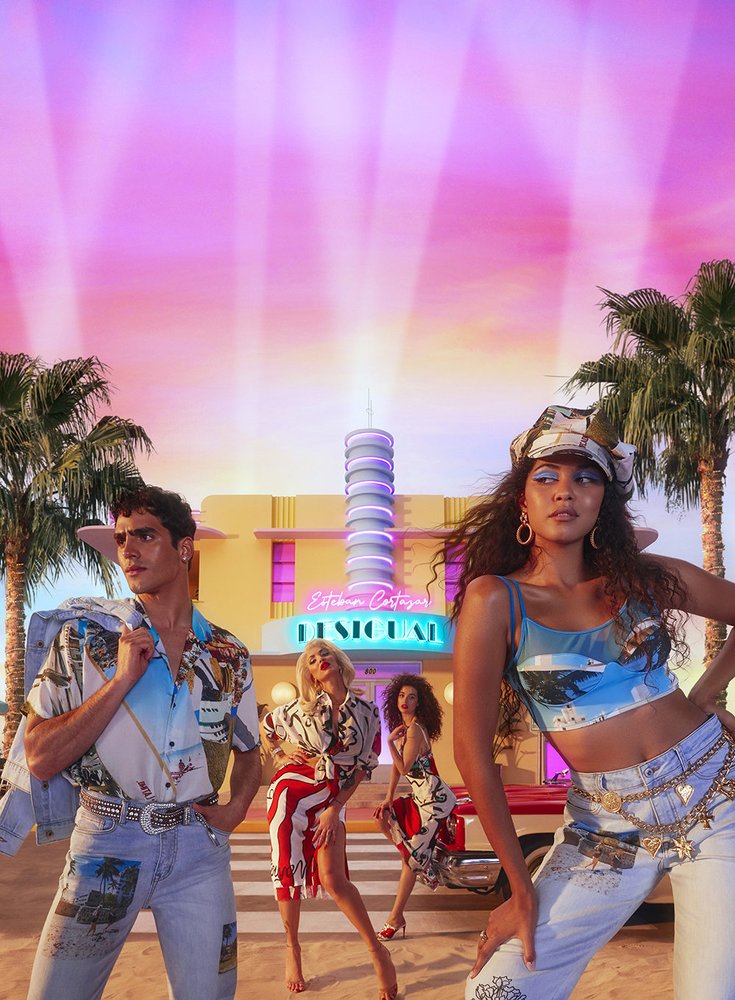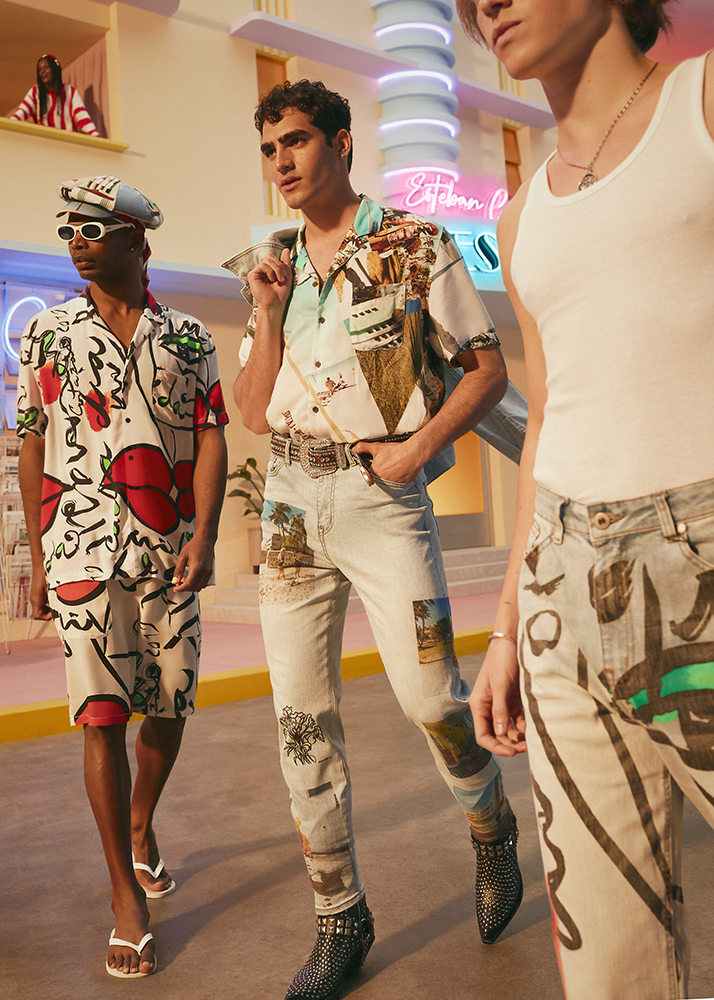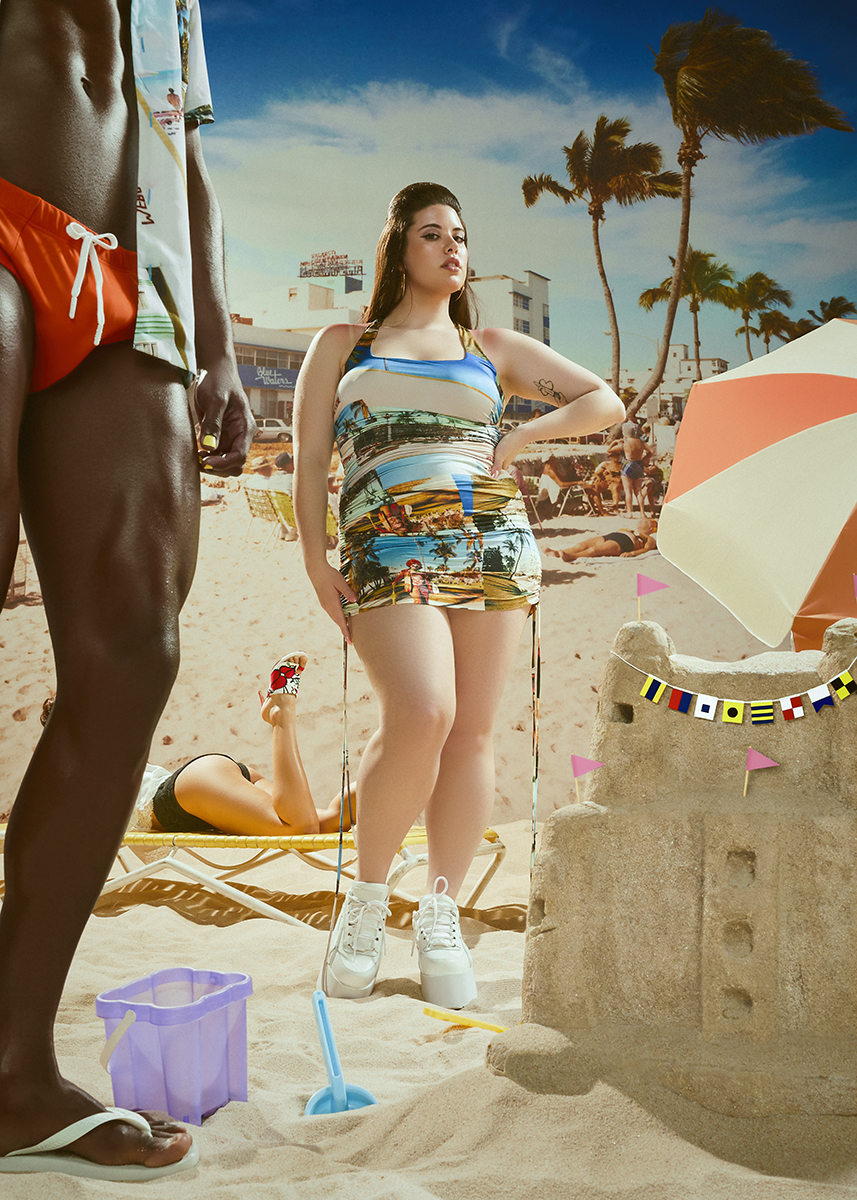May 20, 2021
Esteban Cortazar, who began his fashion career as a teenage wunderkind, returned to his pre-teen days in halcyon hipster
days of nineties Miami, for his new linkup with Spanish label Desigual.
A 15-piece capsule collection, it debuts today entirely online, part of a recent strategy to revamp the vintage-inspired, fast-fashion brand Desigual into something a little cooler, and more sustainable.
The collection – entitled Desigual loves Esteban Cortazar - blends a whole series of kicky allusions – from the arty street photography of Andy Sweet; kitschy Art Deco colors and even the bold graphic imagery from the Colombian-born designer’s father painter Valentino Cortazar.
Ever since he exploded onto the New York runway as a teenage designer, Cortazar has attracted attention with his mashup of wild prints, Colombian imagery and clubbing cool, the product of a youth spent partly in Ibiza. This unisex collection, featuring denim looks; swimwear, cocktail dresses and even dude shirts has plenty of his Latin party-animal DNA.
So, we caught up with the 37-year-old designer, who celebrated his birthday this week, in a Zoom from the Standard Hotel in Miami for his take on his latest project.

FashionNetwork.com: What attracted you to Desigual, why was that compelling?
Esteban Cortazar: It happened very spontaneously, very naturally, it wasn’t a brand that I was connected to, or even knew about their origins. I would see it in different countries and cities, being from Colombia you know, they have quite a following in Latin America. Plus, obviously I go to Spain all the time. And in recent years I started to become intrigued. I met people that worked there and became friends and they started to invite me to their installations that they do in the Art Basel in Miami, or music festivals in Barcelona. So, I started to see all these really cool communities of artists that they attract. They just have good vibes, and they have the best office I ever seen in my entire life. Right on the Barceloneta beach, so everybody is looking at the ocean all day while they work. I thought it was a very progressive vision of Thomas Meyer, the owner of Desigual. And it was founded in 1984, the year that I was born, and founded in Ibiza, a place my dad lived in the '70s. Where he married my mom. So I discovered that we had more things in common. They wanted to attract a new audience, to refresh the brand, and I thought it was a cool challenge for me. So I said why not? And they gave me the freedom to do what I want.
FNW: What are your favorite memories of Miami that you wanted to evoke in the collection?
EC: One of the prints was my father's; a style called El Beso -- which is a kiss, and it's in black and white and red; very freestyle, that he developed in the '90s in Miami. I thought it was interesting to bring that in. Then there is Andy Sweet who did some of the most beautiful photographs in the '60s and '70s in Miami of retired people with very eccentric styles and who lived in South Beach before South Beach became The Fashion Spot. It was really a tiny, small little village with an amazing beach and all these retired people in sort of abandoned hotels. These photographs I've always loved and I wanted to include them. I thought this mix between photography and art as a collage in a Desigual collection was very respectful of their DNA and of mine, because I've gone through phases with prints and colors.
I'm not sure I really appreciated that I was a child growing up on top of the legendary News Café where Gianni Versace went every morning when he was in town. This is a story that a lot of people don't necessarily know. Fashion started for me with the first designer that I ever found out about -- that was Gianni Versace. I remember my dad saying at the time, “Oh, this guy is a very famous designer,” while I was waiting for my school bus to come. The other interesting introduction was to Todd Oldham which was also at that time. So as a kid in South Beach I witnessed his shoots on the beach; when they filmed The Birdcage in 1995; supermodels waiting by trailers to be shot by Patrick Demarchelier; Donatella coming; the artists; the club scene; all the eccentric and flamboyant people in the gay culture; and the drag queens. A little kid growing up around that I think is quite unique. I mean, that doesn't happen every day.
I first saw came to Miami in 1993. I was really enamored by being there and actually it's been a while that I wanted to do project and collection around this story. I thought this was the perfect chance. I also wanted to do a collection that my friends could wear that was fresh and had easy silhouettes but with bold prints.

FNW: One thing that has changed a lot since those days is the idea of sustainability, an ecological element, which is very important to Miami because the place may be flooded eventually by rising sea levels. What way did you put that into the collection?
EC: This is not a trend. It's not a phase. It's a responsibility and we have a long road ahead as an industry and in general in the world to be more conscious, responsible, eco-friendly, in everything we do. So that was one of the first conversations we had with Desigual - how are we going to source fabrics, how are we going to develop these prints or how much water we going to use developing these prints. Can we work with certain recycled fabrics? Because they are much bigger than I am as the brand, so my steps to be more sustainable are very different than Desigual's steps to be more sustainable. So, it was challenging but it was also great because they're also on that page of trying to make a change.
FNW: What made you want to put your father’s art work in the capsule?
EC: I was obviously inspired by my dad’s art and his influence on me since I was little, and for my second show for Ungaro I collaborated with my dad, who did some of the prints. But that was 10 years ago. Then I started collaborating more with him in recent years for my own collection, for beachwear. When Desigual approached me to do this collaboration, being that they also love celebrating art, collages, color, prints, I thought how great to include him into the project to make it feel personal. I want to continue to work with him, as it’s nice to work with your dad.
FNW: You have a pretty spectacular casting; Latino with a lot of twists. Tell me a bit about some of the characters you’ve used?
EC: Originally we were going to shoot the campaign in Miami. I wanted to really bring everything here but it got too complicated because of Covid. So, we said, okay, we're going to take South Beach to Barcelona. And we did, recreating a movie set of Ocean Drive with art deco hotels and little cafes. I wanted to remember through the cast all the things I just mentioned to you about what Miami meant to me.

How diverse it was at this time and continues to be because Miami is such a melting pot, especially for many different Latin cultures. All these diverse groups of creative people from the older eccentrics to the drag queens to the beautiful people. I wanted to somehow reflect that in a cast that felt 'today.' That’s why we have Daniela Santiago, who is an amazing actress in our new series on HBO called La Veneno -- the story of Christina La Veneno, one of the iconic trans women that came out of Spain in the '90s. And we have Yendry, an up-and-coming amazing Latin singer; and Michelle Ellie, a personal friend who has been an inspiration for me forever. And the different people we discovered through Instagram: from a bodybuilder; to the drag queen Alaska Nebraska who is super. All seen through the eyes of the little boy that is supposed to be me in the campaign.
FNW: Finally, what do you want people to think when they see this collection?
EC: I want them to feel good; to be reminded of spontaneity and of the freedom that we're all missing. Be reminded of how good it feels to dance, and have optimism that there will be a sunrise and the things will get better. And to stay positive. That’s always been in my nature, and they have that kind of philosophy at Desigual as well. I like them because they're the kind of brand that they're not really a trend bazaar, and are not copying things around. They have their own point of view. It's bold. Either you like it or you don't, and that’s cool.
